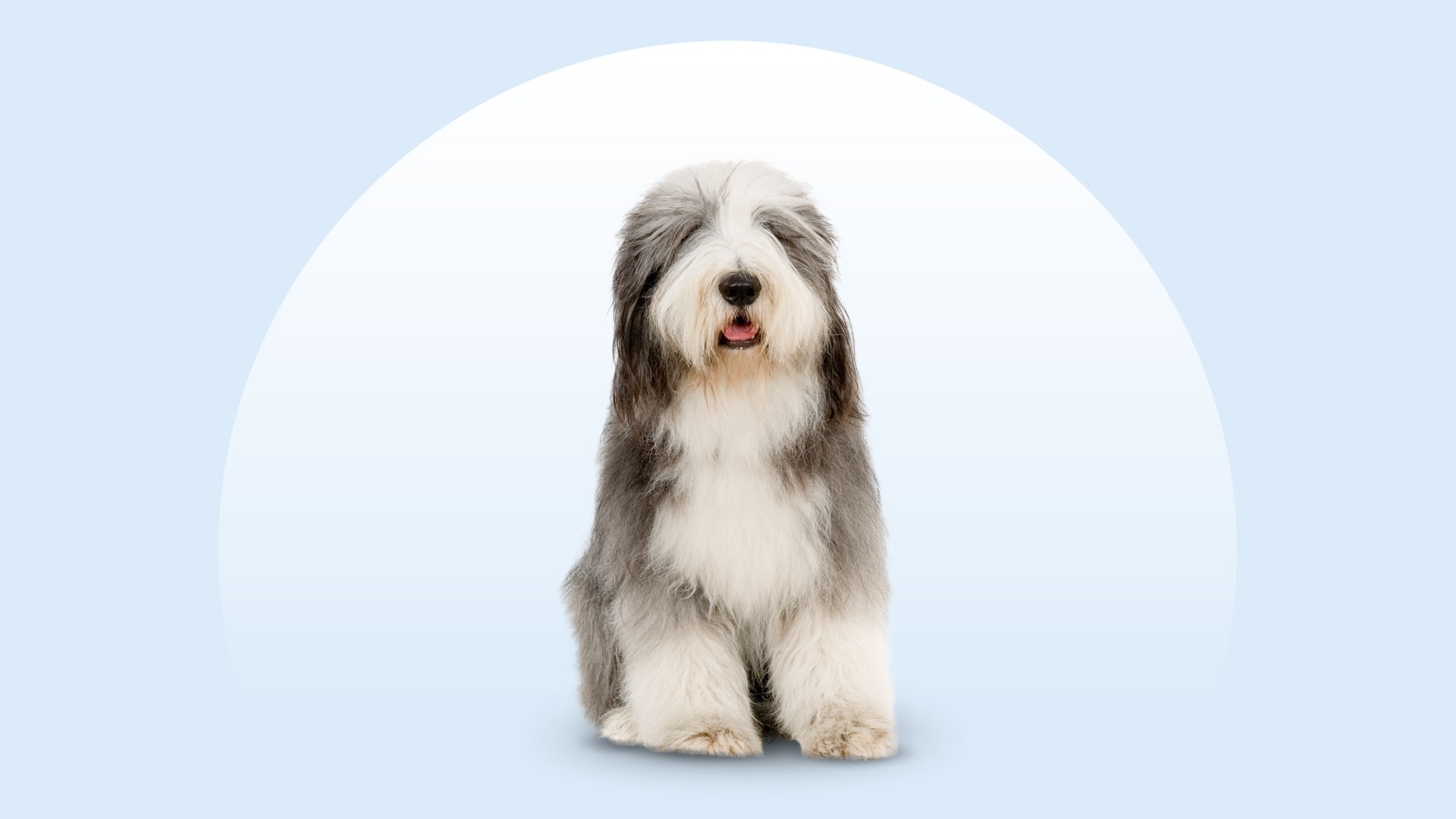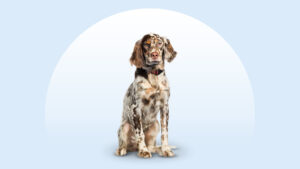Bearded Collie
Updated December 15, 2025
Bearded Collie
Updated December 15, 2025
Intelligent and adventurous, this medium dog needs lots of exercise, daily grooming and plenty of human interaction. Because Bearded Collies are born leaders who thrive on activity, they're best for pet parents (including first-time pup parents!) who can keep their minds and bodies busy.
Quick Learner, Adventurous, High Energy
Male: 45-55 pounds
Female: 45-55 pounds
Male: 21-22 inches
Female: 20-21 inches
12 to 14 years
Black, Blue, Brown, Fawn
You’re packing your gear for a weekend camping trip when your beloved Bearded Collie scampers over and pricks their ears in anticipation. There’s no question—they’re coming with you. These dogs are as rambunctious as they are smart, so they’re always up for a new adventure, whether it’s a quick trip to the store or a long hike in the woods. Plus, they’re herding dogs, so you can count on them to keep tabs on your family and friends, too. You smile to yourself knowing this weekend’s going to be full of fun and excitement—for both you and your dog.
Bearded Collie Characteristics
Bearded Collie Appearance
The first thing you’ll notice about a Bearded Collie is their shaggy double-coat bouncing in the wind as they run toward you with agility and speed. But beneath that abundant mane is a surprisingly lean dog for their size. Weighing in around 50 pounds when full-grown, these rambunctious pups peer out from their bangs with shining, inquisitive eyes that reflect their desire to be with you. Their coats range in color from black or gray to light brown, and your pup’s color may change as they grow up.

- Ears
Bearded Collies' floppy ears hang down and are covered in long hair. They tend to perk up at the base when the dog is particularly alert.
- Eyes
Beardies have large, expressive eyes and arched eyebrows. Their eye color corresponds to their coat: Black dogs have dark eyes while silver dogs have blue-gray eyes.
- Nose
They typically have a large, square-shaped nose that ranges in color from black to gray.
- Coat Length
Double-coated Beardies have soft, furry undercoats and long, shaggy topcoats.
- Coat Color
Bearded Collie colors range from black to yellowish tan and some have white or tan markings. The coat color sometimes lightens as they age.
- Tail
They have a long, hairy tail that often curves and swishes when the dog's excited.
Bearded Collie Temperament
Inquisitive and independent, Bearded Collies are born leaders. These highly intelligent dogs thrive on activity, so you’ll want to keep their minds and bodies busy. Otherwise, if they get bored, Beardies might come up with their own list of fun activities (think: herding friends and family, stampeding wildly through the house or destroying the furniture).
Like Border Collies, Beardies were bred for herding sheep. Their herding behavior can be an issue in chaotic households with young kids and other animals. But this doesn’t mean they can’t excel in family homes. In fact, your ever-alert Beardie will eagerly steer friends and family out of danger. With early training, you can help your Beardie know when it’s OK to use those herding instincts. It’s also a good idea to teach children of all ages how to properly interact with dogs.
Bearded Collies are rambunctious at all ages, which can be entertaining for friends and family. These athletic dogs love chasing, playing and running alongside you while doing everything from hiking to running errands. Instead of being left at home while you jog, Beardies would love to come with you. There’s no such thing as too much activity for these pups.
Bearded Collie dogs’ high energy level and keen intelligence can sometimes lead to a bit of a strong-willed streak, especially in training. It’s not that they don’t want to obey; they just think their way is better. Starting their training and socialization while they’re puppies will help them see that you’re pretty smart yourself.
How to Care for a Bearded Collie
Bearded Collies are incredibly smart, but that doesn’t mean they don’t need help from their human families. This medium-sized dog needs lots of exercise, daily grooming and plenty of human interaction. As independent thinkers, they thrive with firm structure and expectations so that they don’t stray too far off course.
Grooming
Training
Diet
Exercise
Environment
Bearded Collie Health
Bearded Collies are a generally healthy breed with a life expectancy of 12-14 years, but they are prone to a few health issues. Look out for these Bearded Collie health conditions in advance so you can keep your pet healthy and happy.
- Autoimmune Diseases: Bearded Collies are prone to developing autoimmune diseases, such as hypoadrenocorticism (Addison’s disease), hypothyroidism, pemphigus, low platelet (ITP) or red blood cell count (IMHA). If your vet suspects an autoimmune disease, they will probably order blood tests. Most autoimmune diseases are treatable with medications.
- Hip Dysplasia: Bearded Collies are less prone to joint issues than giant breed dogs, however, researchers have found that about 5 percent of Beardies develop hip dysplasia, a condition where the hip joint is malformed causing the joint to be loose. Symptoms of hip dysplasia include limping, pain or decreased mobility. Treatments typically include weight management, joint supplements, pain medication, physical therapy and, in severe cases, potential surgery.
- Eye Problems: Bearded Collies are prone to eye problems, including cataracts and progressive retinal atrophy (PRA). Cataracts can often be treated with surgery, but there is no treatment for PRA. If you suspect your pup is having trouble with their vision, please check with your veterinarian.
Bearded Collie History
The Bearded Collie breed’s origin and history can be traced back to the Scottish Highlands, where the dogs were raised to help shepherds by herding and driving sheep across the rugged land. The dogs were prized for their energy, wit and stamina—they worked long days. Because of their role and geography, they were often called Highland Collies or Mountain Collies. Somewhere along the line, these humble herding dogs found their way into the homes of the Scottish elite. They became quite fashionable, even appearing in portrait paintings with their families. By the early 1800s, the Bearded Collie types had developed a rather standard look, temperament and set of traits that match the breed of today. Beardies were a well-kept secret of the Scottish Highlands; they made their way to the United States only in the mid-20th century. The American Kennel Club formally recognized the breed in 1983.
So, where should you look for Bearded Collie puppies? You can find a list of reputable breeders on the American Kennel Club’s website. The cost of a pup can range $1,500-$2,500. For that price, you’re likely getting a pup who’s been screened for health and temperament issues and may come with pedigree papers. If you’re interested in adopting a Beardie, reach out to a Bearded Collie rescue organization or your local animal shelter. You can also search Chewy’s database of adoptable dogs in your area.
FAQs
Do Bearded Collies shed?
How long do Bearded Collies live?
Are Bearded Collies good family dogs?
Do Bearded Collies bark?
How big do Bearded Collies get?
Expert input provided by veterinarians Dr. Amanda Williams, DVM, of Furry Friends Adoption, Clinic & Ranch in Jupiter, Florida; Dr. Linda Aronson, DVM, of PetShrink; and Emilia Byrum, KPA-CTP, RVT, owner and head trainer at Maggie’s Foundation: Pet Training LLC in Indianapolis, Indiana.
Breed characteristic ratings provided by veterinarian Dr. Sarah J. Wooten, DVM, CVJ, a veterinarian at Sheep Draw Veterinary Hospital in Greeley, Colorado; dog trainer and behavior consultant Irith Bloom, CPDT-KSA, CBCC-KA, CDBC, owner of The Sophisticated Dog, LLC, in Los Angeles; and certified animal behavior consultant Amy Shojai, CABC, in Sherman, Texas.
The health content was medically reviewed by Chewy vets.








